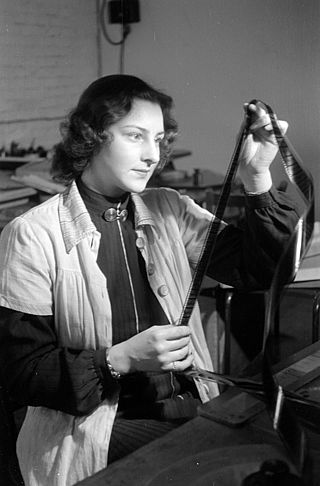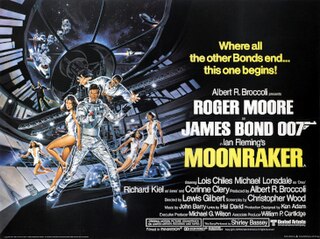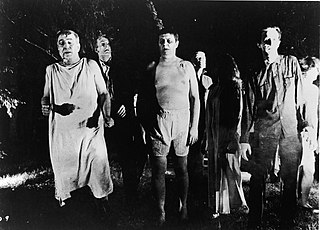This article needs additional citations for verification .(February 2024) |
In film production, a set piece is a scene or sequence of scenes whose execution requires complex logistical planning and considerable expenditure of money.
This article needs additional citations for verification .(February 2024) |
In film production, a set piece is a scene or sequence of scenes whose execution requires complex logistical planning and considerable expenditure of money.
In its original meaning, the term is used to label scenes that require a whole new set of stage scenery to be built. Most early movies were shot in large studios, with potentially expensive sets. When a screenplay would require a new set to be built, filmmakers would often make the scene a high point of the movie, to justify the expense. [1] According to Adam O'Brien, a set piece is "a sequence in a film when we are invited to appreciate (if not consciously consider) the logistical efforts of the filmmaking process, including design, performance and recording." [2]
The term is often used broadly to describe a sequence in which the film-maker's elaborate planning is considered to allow for the maximum pay-off for the audience, such as a thrilling action sequence or awe-inspiring science-fiction sequence. The term is often used to describe any scenes that are so essential to a film that they could not be edited out or skipped in the shooting schedule without seriously detracting from the enjoyability, intensity, impact, coherence or memorability of the finished work. Often, screenplays are written around a list of such set pieces, particularly in high-budget "event movies". The term is sometimes extended to refer to cinematic portions in video games. [3]
A set piece may or may not be integral to the plot. A James Bond film usually begins with a set piece that has little relation to the main plot of the film. On the other hand, a dramatic film may have set pieces at major plot points, providing dramatic pay-off, resolution, or transition.
Set pieces are very often planned meticulously using storyboards, screen-tests, and rehearsals, in contrast to smaller scenes where the director and actors may be more improvisational. Each action requires the combined efforts of different departments: set builders, physical effects, and special visual effects. On most films, different groups of people will work on different set pieces individually since they can take a long time to prepare before shooting. For example, the car chase in The Matrix Reloaded took months to prepare and cost $30 million, including $5 million to build the freeway set.
Notable examples of set pieces include the Snake Pit in Raiders of the Lost Ark , the Death Star Trench Run from Star Wars , the storming of the volcano lair in the James Bond film You Only Live Twice , the burning oil rig in There Will Be Blood, and the Tyrannosaurus escape in Jurassic Park. Alfred Hitchcock referred to set pieces as crescendoes or "bumps" and tried to put three of them in each of his movies. In Psycho , these are the shower murder, the murder on the stairs, and the discovery of "Mother". One of the most well known set pieces is the "Ride of the Valkyries" helicopter attack scene in Apocalypse Now whose planning was shown in Hearts of Darkness: A Filmmaker's Apocalypse .

Film editing is both a creative and a technical part of the post-production process of filmmaking. The term is derived from the traditional process of working with film which increasingly involves the use of digital technology. When putting together some sort of video composition, typically, you would need a collection of shots and footages that vary from one another. The act of adjusting the shots you have already taken, and turning them into something new is known as film editing.

A storyboard is a graphic organizer that consists of illustrations or images displayed in sequence for the purpose of pre-visualizing a motion picture, animation, motion graphic or interactive media sequence. The storyboarding process, in the form it is known today, was developed at Walt Disney Productions during the early 1930s, after several years of similar processes being in use at Walt Disney and other animation studios.
A screenplay, or script, is a written work produced for a film, television show, or video game by screenwriters. A screenplay written for television is also known as a teleplay. Screenplays can be original works or adaptations from existing pieces of writing. A screenplay is a form of narration in which the movements, actions, expressions and dialogue of the characters are described in a certain format. Visual or cinematographic cues may be given, as well as scene descriptions and scene changes.

A film transition is a technique used in the post-production process of film editing and video editing by which scenes or shots are combined. Most commonly this is through a normal cut to the next shot. Most films will also include selective use of other transitions, usually to convey a tone or mood, suggest the passage of time, or separate parts of the story. These other transitions may include dissolves, L cuts, fades, match cuts, and wipes.
Filmmaking or film production is the process by which a motion picture is produced. Filmmaking involves a number of complex and discrete stages, beginning with an initial story, idea, or commission. Production then continues through screenwriting, casting, pre-production, shooting, sound recording, post-production, and screening the finished product before an audience, which may result in a film release and exhibition. The process is nonlinear, as the director typically shoots the script out of sequence, repeats shots as needed, and puts them together through editing later. Filmmaking occurs in a variety of economic, social, and political contexts around the world, and uses a variety of technologies and cinematic techniques to make theatrical films, episodic films for television and streaming platforms, music videos, and promotional and educational films.

Principal photography is the phase of producing a film or television show in which the bulk of shooting takes place, as distinct from the phases of pre-production and post-production.

Screenwriting or scriptwriting is the art and craft of writing scripts for mass media such as feature films, television productions or video games. It is often a freelance profession.
A money shot is a moving or stationary visual element of a film, video, television broadcast, or print publication that is disproportionately expensive to produce or is perceived as essential to the overall importance or revenue-generating potential of the work.
Second unit is a discrete team of filmmakers tasked with filming shots or sequences of a production, separate from the main or "first" unit. The second unit will often shoot simultaneously with the other unit or units, allowing the filming stage of production to be completed faster.

A rehearsal is an activity in the performing arts that occurs as preparation for a performance in music, theatre, dance and related arts, such as opera, musical theatre and film production. It is undertaken as a form of practising, to ensure that all details of the subsequent performance are adequately prepared and coordinated. The term rehearsal typically refers to ensemble activities undertaken by a group of people. For example, when a musician is preparing a piano concerto in their music studio, this is called practising, but when they practice it with an orchestra, this is called a rehearsal. The music rehearsal takes place in a music rehearsal space.
Television crew positions are derived from those of film crew, but with several differences.
This article contains a list of cinematic techniques that are divided into categories and briefly described.
Previsualization is the visualizing of scenes or sequences in a movie before filming. It is a concept used in other creative arts, including animation, performing arts, video game design, and still photography. Previsualization typically describes techniques like storyboarding, which uses hand-drawn or digitally-assisted sketches to plan or conceptualize movie scenes.
A production board, stripboard, or production strip is a filmmaking term for a chart displaying color-coded strips of paper, each containing information about a scene in the film's shooting script. The strips can then be rearranged and laid out sequentially to represent the order one wants to film in, providing a schedule that can be used to plan the production. This is done because most films are shot "out of sequence," meaning that they do not necessarily begin with the first scene and end with the last. For logistical purposes, scenes are often grouped by talent or location and are arranged to accommodate the schedules of cast and crew. A production board is not to be confused with a stripboard used for electronics prototyping.

Thunderball is a 1965 spy film and the fourth in the James Bond series produced by Eon Productions, starring Sean Connery as the fictional MI6 agent James Bond. It is an adaptation of the 1961 novel of the same name by Ian Fleming, which in turn was based on an original screenplay by Jack Whittingham devised from a story conceived by Kevin McClory, Whittingham, and Fleming. It was the third and final Bond film to be directed by Terence Young, with its screenplay by Richard Maibaum and John Hopkins.

Moonraker is a 1979 spy-fi film, the eleventh in the James Bond series produced by Eon Productions, and the fourth to star Roger Moore as the fictional MI6 agent James Bond. The third and final film in the series to be directed by Lewis Gilbert, it co-stars Lois Chiles, Michael Lonsdale, Corinne Cléry, and Richard Kiel. Bond investigates the theft of a Space Shuttle, leading him to Hugo Drax, the owner of the shuttle's manufacturing firm. Along with astronaut Dr. Holly Goodhead, Bond follows the trail from California to Venice, Rio de Janeiro, the Amazon rainforest, and finally into outer space to prevent a plot to wipe out the world population and to recreate humanity with a master race.

Z movies are low-budget films with production qualities lower than B movies.

A film – also called a movie, motion picture, moving picture, picture, photoplay or (slang) flick – is a work of visual art that simulates experiences and otherwise communicates ideas, stories, perceptions, feelings, beauty, or atmosphere through the use of moving images. These images are generally accompanied by sound and, more rarely, other sensory stimulations. The word "cinema", short for cinematography, is often used to refer to filmmaking and the film industry, and the art form that is the result of it.
This glossary of motion picture terms is a list of definitions of terms and concepts related to motion pictures, filmmaking, cinematography, and the film industry in general.

Stage clothes worn by actors who portray characters that are shot and wounded in movies, TV shows, or theatre productions are modified to conceal special effects equipment such as squibs, wires and controllers are commonly referred to as "dead-character costumes". These costumes are a crucial element to create a captivating and dramatic scene. Typically, several identical sets of these costumes are prepared for the planned number of takes as "consumables" and are used only once. After use, they are placed on the "dead-character rack" and not reused, unlike other clothing articles that return to the costume shop.